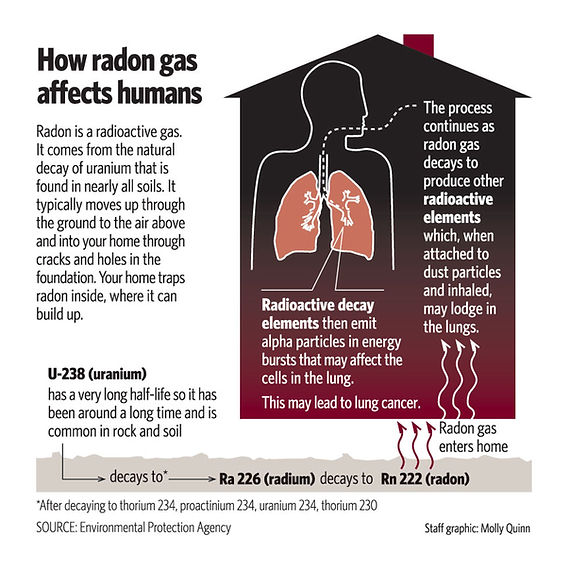
WHAT IS RADON AND WHY IS IT SO DEADLY?
Radon Is Known As "The Invisible Killer"
Radon is a natural colorless, tasteless and odorless gas that causes lung cancer. Radon can reside at dangerous levels inside homes, apartments, schools and other buildings. Exposure to radon is the second leading cause of lung cancer in the United States, after smoking. According to the EPA, radon-related lung cancers are responsible for a recently estimated 22,000 deaths annually in the United States as of 2020.

During the Federal EPA's study in 2003, radon was estimated to cause 21,000 lung cancer deaths per year. This EPA 2003 "Assessment of Risks from Radon in Homes Report" (EPA 402-R-03-003) was then compared to the number of deaths from other popular annual causes as studied by the Centers for Disease Control and Prevention (CDCP). The CDCP numbers were released to the public in their 2005-2006 "National Center for Injury Prevention and Control Report" and also in their 2006 "National Safety Council Report." The number has since grown from 21,000 lung cancer deaths annually caused by radon gas in 2003, to a recently increased number of 22,000 lung cancer deaths caused by radon gas in 2020.

HOW DOES RADON ENTER MY HOME?
Radon Dangers and Home Entry
Radon forms naturally from the decay of minerals in the earth. Uranium in soil breaks down to form radium, which ultimately decays and turns into radon gas. Once formed, radon gas enters your home through sump pump pits, cracks in walls, basement floors, foundations, and other openings. As radon decays in your home, it releases radioactive decay products (RDPs) which emit dangerous alpha particles in energy bursts, that once inhaled, damages the cells in your lungs and ultimately causes lung cancer. Because radon gas comes from rock and soil, it can be found anywhere. Exposure even to limited concentrations, like those found outdoors, is impossible to avoid. However, when radon gets trapped indoors, it may exist in dangerous concentrations harming your entire family plus pets.

WHAT ARE THE HEALTH EFFECTS OF RADON?
Why Should My Family Be Worried?
Are your children and pets safe in your family's home? Probably NOT.
The EPA states 22,000 people die every year from cancer caused by radon gas in their homes. Radon is the #1 cause of lung cancer for non-smokers and the #2 cause of lung cancer deaths overall. Exposure to radon gas causes no immediate symptoms, but the long-term threat of lung cancer is significant to everyone.
People who have never smoked make up approximately 2,900 of the estimated 22,000 radon-related lung cancer deaths each year. The health hazard comes from radioactive particles released when radon decays. These particles can be inhaled into the lung and bombard your cells with dangerous, cancer-causing radiation. Smoking and radon exposure can separately increase the risk of lung cancer. But if you smoke, know that exposure to both exponentially enhances your risk of lung cancer.



HOW CAN I PROTECT MY FAMILY FROM RADON?
Radon Testing and Mitigation



Every home should be tested for radon gas. Radon has been found at elevated levels in homes in every state and the only way to know is to test. Your home can have elevated levels of radon while your neighbor's home does not due to soil content differences around each building. Testing is the only way to determine if you have a problem. Radon testing is easy and inexpensive and it could save your life. Thousands of lung cancer deaths could be avoided each year if home and building owners acted to test and mitigate.
The only way to detect a buildup of radon in your home is to test the air. Initial short-term tests last 48 hours. During this time, the annually EPA certified radon meter is placed undisturbed in the lowest level regularly used room in your home. Radon gas is measured in picocuries per liter (pCi/L) of air. The EPA recommends taking mitigation action to reduce radon if the result is 4.0 pCi/L or greater and to consider similar actions when the radon level is between 2.0 and 4.0 pCi/L. The ultimate goal is to get your radon level to the lowest level possible.
If your new-build or existing home was tested with elevated levels of radon, you can fix the problem by having an active fan-driven radon mitigation system installed. A radon mitigation system consists of a vent pipe, active fan blower, and the proper sealing of cracks and sump pump pits. This system collects radon gas from underneath the foundation and vents it to the outside of your home above your roof line. Your radon mitigation system must be installed by nationally certified radon mitigation professionals....such as Radon Reaperz™.
The Radon Reaperz™ offers nationally licensed and state of the art Radon Mitigation and Testing Services for apartments, residential home installs, and all your corporate compliance needs.
Call the Radon Reaperz™ TODAY and we can save your lives and change your fate.